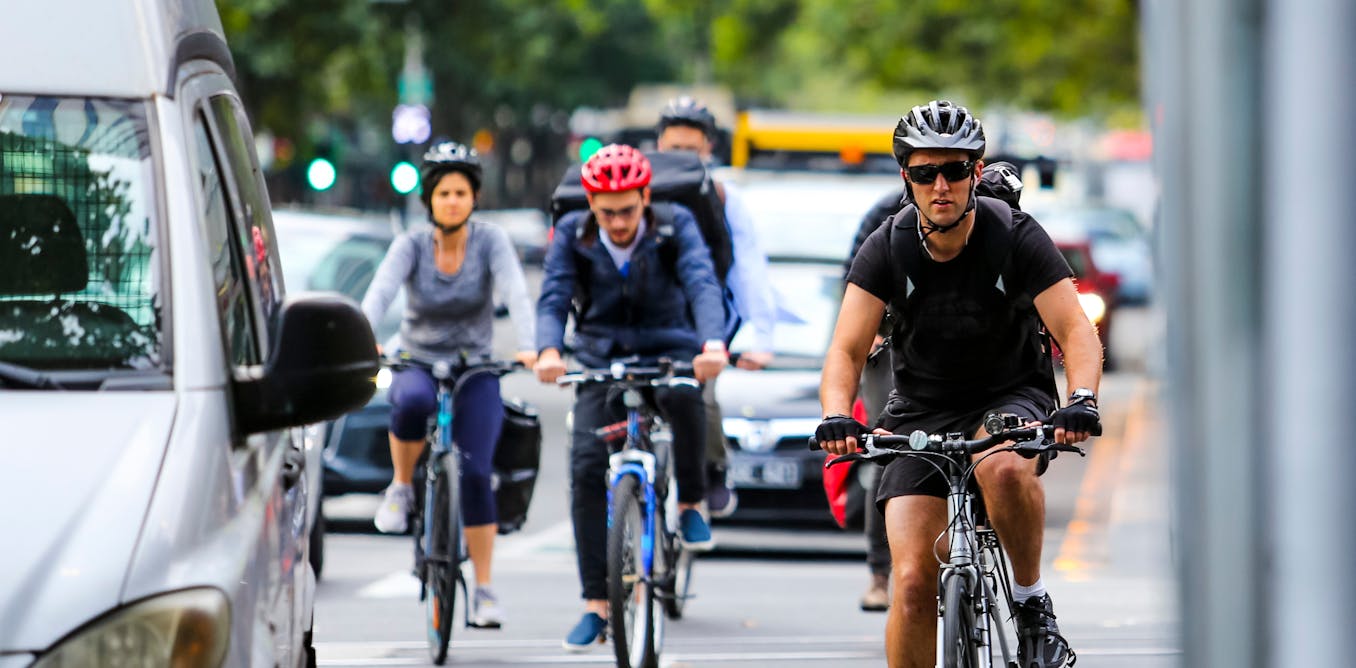Because so many Australian drivers are actively hostile to cyclists.
You misspelled “murderous Psychopaths”
I know several people who believe that might-is-right on our roads and consider cyclists to be a “burden on society since they don’t pay fuel tax.”
The tragic irony is that some of them ride motorbikes and don’t see the hypocrisy of their opinions.
For me it’s because almost nothing is within an hour’s ride. My drive to work isn’t far, but it’d be a 90 minute round trip on a bike.
Think how damned fit you’d be.
“It never gets any easier, you just go faster.”
- Better cycling infrastructure. Yeah, no shit. We need more paths, more direct paths, and more connected paths. You should be able to go anywhere you want using a route that it at least as direct as the most direct driving route, by bike, without ever sharing a road with cars above 30 km/h, and with a minimal number of road crossings where the cars get priority.
- Use AI to identify where cycling infrastructure needs to go. 🙄 Or you could just ask cyclists. We’ve got no shortage of ideas of places that are severely lacking already. Maybe the AI could be useful once most of the basic network is done, but not today.
- Improve transport modelling to include cycling. Yes! Add in induced demand effects on infrastructure for cycling, public transport, and cars. Use models that understand traffic evaporation when reducing road widths or adding modal filters. Our transport engineers are currently woefully behind the times.
- Politicians need to actually care about cycling. Yeah, no shit.
- Make active transport funding a priority. Yup. Our councillors love to harp on about how they spent X amount on cycling infrastructure, but they never put that in context of how much is spent on roads. But also, let’s make sure that money goes where it’s most useful. Spending billions building one green bridge is great, but is still much less useful than building many kilometres of good separated bikeway for the same price. (The real answer is to do both!)
- Recognise the health benefits of cycling. Yes, but this isn’t really an actionable item. It’s just more reason to do the above items, particularly pointing to 4.
deleted by creator
No, I just think it’s silly to talk about applying AI to something that just manifestly does not need AI. It’s a dumb buzzword at best, an excuse to spend less money actually building infrastructure because more money is going to AI consultants at worst.
Like I said, if it were about filling in the little cracks once we have a really good overall network, I could maybe get behind it. But right now there’s just zero need for it, because the stuff that’s missing is so obvious and there’s so much of it. At least in Brisbane, the Council could decide to triple its spend on bike infrastructure and still take a decade before the big problems we’ve been calling for action on for years are all exhausted.
deleted by creator
How is the government (who has to end up building the stuff) getting this AI data? They’re paying some AI company for it. Money that would be better spent directly on infrastructure we already know we need.
The better question is: without the technobro hype, what do we actually have to gain from this AI technology?
deleted by creator
First, AI is garbage at best, a shield to look busy, move money, and claim benevolence at worst.
Secondly, who is funding the AI?
If I were a company that makes more money the less people cycle or work from home, I’d rename one of my departments the AI consultant department. Then I could pay myself as much as I wanted, be able to spew buzzwords at investors/governments/naysayers, generate nothing of value (as intended), then say to all the governments and cyclists: “Sorry, we spent $X and it looks like putting more gas guzzling cars on the road is still the best solution”.
deleted by creator
I remember reading on the Conversation years ago one problem is we’ve been trained to see everyone on the road as equal. That’s not the case, someone in a car is surrounded by steel in a one tonne machine that can go 100km/h, but they’re the one missing out when stuck behind a cyclist or a cycle lane is implemented. Spaces need to be planned with a focus on the movement of people first, then cars.
We also need more complete cycling infrastructure. You look at the cycle lanes on maps and the paths look like a minecraft village. They’re disconnected and don’t link up anywhere. Also, a metre of green paint at the edge of a three lane road where the speed limit is 80km/h is not cycling infrastructure.
I used to ride the 33kms into the city for work, but that’s because I like cycling and got all the gear for it. The ride was either on paths or quiet roads but more could be done to link up sections and make the ride faster.
There was another article about the ‘cycling donut’ effect in Melbourne where people close to the CBD could walk or take trams, further out people rode because it was that sweet spot of a distance, and beyond that people drove or took public transport because everything was too far away.
Australia is a perfect candidate for cycling infrastructure because our cities are mostly flat, it never gets as cold as it does in Europe or NA, and the heat is generally more of a dry heat which can be avoided with some shade and a breeze. Our cities should be designed around 3-speed town bikes instead of cars.
33km on the bike as a commute is amazing! I only travel 12km and that is 25 minutes each-way.
Having the energy and commitment to ride 33km at the end of a long work day is very impressive. That has to be over an hour each way.I only did it once a week and I would ride about halfway home then get the train. I did make it all the way home once but it was a slog. My cycling computer said the ride in was about an hour and a half
I’m just imagining a dedicated 2-way cycle path, lined with tall trees the whole way so it’s in the shade most of the day. What a beauty that would be!
I’m already jealous of you Aussies for the affordability of solar and your abundant sunshine making it highly efficient. Up here in Canada where I live solar is mostly a luxury and bike lanes and paths exist but are rather unpleasant to use when they’re covered with snow and ice from December to May.
The heat in qld. The humidity in summer cannot be understated.
People whinge about all kinds of things as excuses for why cycling doesn’t happen. In Canada it’s “it’s too cold”. In the UK it’s “too wet”. In Brisbane I alternately see “too hot” and “too hilly” brought up as excuses.
It’s all bullshit.
The evidence tells us pretty clearly. Infrastructure is the whole thing. With good infrastructure, people will cycle in any weather. It’s what happens everywhere in the world, every time they build actual good infrastructure.
And for what it’s worth, I find it much easier to cycle in Brisbane’s summer than its winter. Our winters are an awkward in-between temperature where you can’t rug up properly because if you do you get too hot while riding. But it’s too cold to go out in shorts. Speaking objectively, those Canadians are closer to having a good point. Warm weather doesn’t make your tyres slip; doesn’t require snow to be ploughed off of the path.
If I ride in summer to a meeting, I’m going to need a shower and a full change of clothes. That’s not practical. Sure, at can implement infrastructure (showers) everywhere, and places to store our sopping wet sweaty clothes maybe, but it’s just not going to fly.
Definitely introduce infrastructure, and get people on bikes.
But let’s not live in fantasy land that the humidity makes riding to work in summer a no for most people, who need to be clean, dry, and have non sweat soaked clothes at work.
That comes down to infrastructure though.
My workplace has a bike storage room, change rooms, showers, irons and lockers, so the problems you’re describing as impractical are quite practical for me.
That’s nice. I just don’t see showers and change rooms, with bike storage and whatnot becoming the norm. It would be great if it did, but I think it would be a long way off. Fingers crossed though
Everywhere that I’ve worked so far has had an End of Trip facility except for my supermarket job as a teenager.
I’ve worked in quite a few places in Brisbane, and never had a shower (that I was aware of).
That was a while ago though, so good to see things are changing.
I remember one particular summer, just walking from the valley train station, about 1 km to work. It was before 8am. A very hot summer.
By the time I got to work my shirt was stuck to me from the sweat. Soaked. That was before 8am.
I can’t imagine riding. I’d have been dripping puddles if I’d have ridden.
It won’t be the norm for workplaces for a long time, but my city also has semi public spaces that offer the same in the CBD. Basically, for a subsidised monthly fee, you have access to the facilities I described above, in a dedicated bike storage space. And that could easily become normalised
It won’t be the norm for workplaces for a long time
I have no idea what they’re talking about, because it’s already the norm. Last time I was applying for work, asking about end of trip facilities was one of my routine questions, and they always had a good answer to it. Most CBD offices have them. As do other major employers like unis, schools (via the change rooms used for PE, if nothing else), and hospitals.
And if your particular CBD building doesn’t, there’s the Cycle2City EoT facilities, which are cheaper than public transport and much cheaper than paying for CBD parking.
Last time I was applying for work, asking about end of trip facilities was one of my routine questions, and they always had a good answer to it
Oh, that’s good to know!
I’ve been with my current employer for longer than I’ve been cycling to work, so I don’t have any other points of comparison.
It would become normal if more people started riding to work and requesting it.
You can definitely work in an office job, bring your clothes in your bag and get changed at work.
If that’s not your thing, catch PT. Nobody’s saying you have to do the cycling thing. But plenty of people ride into offices for work and wear their smart clothes just fine.
But that’s just…straight-up not true? Just ride a little bit less intensely. It’s really not that bad. I’ve done it for years—including in a city far hotter and more humid than Brisbane.
Or yeah, have a shower. It’s pretty easy. Most office buildings, schools, universities, and hospitals have EoT facilities. And you can skip the morning shower at home.
Those are all legitimate reasons to not ride. Don’t be “that guy” who has to force his way of life on others to feel validated.
Nobody is forcing anybody to do anything, except the pro-car crowd who come up with every possible excuse to avoid building better infrastructure for non-car uses.
except
Yes, except the pro-car people.
Why are you so angry
I ride all year round in Brissie. I find my comfort level depends on when I ride, distance, speed and my bike setup.
First, I ride to and from work in the morning and arvo when it’s cooler, not in the middle of the day.
I ride 6km each direction which is manageable. In winter I barely break a sweat. In summer I have a shower on each side. I can and sometimes do get away without showering by riding slowly. Or I just catch PT if I’m going somewhere else after work.
The other thing I noticed is that not wearing a bag helps a lot with reducing sweat on my back. I have a basket on the back of my bike and just throw my bag in. A lot of other people use pannier bags.
Panniers are a game changer. Love mine
Reforming mandatory helmet laws, by either abolishing them altogether or making them applicable only on busy roads, would help. The laws deter mass uptake of cycling by framing getting on a bike as a dangerous extreme sport rather than a form of active mobility. The fact that they are applied to advertising as well, with tourism ads for Amsterdam having helmets photoshopped onto all the cyclists, further reinforces this framing and deters casual cyclists.
But cycling is dangerous - do we really want to put our ideology ahead of peoples’ safety? I’m not saying cars are safe, but they are required to have seat belts (which you are required to use) and I assume airbags are also mandatory. We shouldn’t downplay the risks associated with an activity to get the “ignorant masses” to do it - that is misleading. We need more people out of cars and on bikes or public transport but we shouldn’t get there by lying, good infrastructure will be a major factor.
Statistically, it’s been fairly well understood for a while now that the benefits of a larger number of people cycling outweigh the safety risk of some of those people not wearing a helmet.
Infrastructure and keeping people separate from cars is more important, but mandatory helmet laws are a net detriment to public health.
There’s entire swathes of people who just can’t really have their hair messed up or it would affect them professionally. In Europe people tend to not wear helmets and it’s not like it’s a daily massacre in the streets.
I don’t like the whole Darwin-Awards/Eugenics dichotomy but I can’t comprehend anyone stupid enough to think that having a fancy haircut is more important than their brains being on the inside of their heads.
If only one man dies of hunger, that is a tragedy. If millions die, that’s only statistics.
There are different types of cycling. I would always wear a helmet to work because I live 6km away and it’s a decent ride. There are hills and I often get to a reasonable speed.
Compare that to someone living in South Brisbane commuting to the CBD, or someone going for a leisurely bike stroll on the riverwalk - they may not go fast at all. We don’t wear helmets whilst walking or jogging, but why is it mandatory for a slow ride?
The big reason helmets can be offputting is because they can mess up your hair. If the city wants to encourage people who live relatively close to their jobs to ride in, more flexibility on helmets could be a good thing.
FWIW I do think helmet safety should always be encouraged. Riding down a hill? Going more than a leisurely stroll? Wear a helmet. Makes sense. But it’s really not that necessary for people who are riding slow.
I agree that the helmet laws are unnecessary, but I think they’re far from the most important thing compared to having good infrastructure to ride on.
I hadn’t ridden properly for a couple of decades, then after Covid inherited a bike and decided to ride on some bike tracks. Had a great time and now I try to ride anything 10km and under.
It took a little while to get used to riding on roads, but I’ve overcome that.
Also, I’ve noticed that there are lots of great bike tracks but even more missing links to join them all together.
I live 42 km from work, and I have school drop off’s and pickups on the way. I can’t live where I work, and the kids education opportunities means I can’t have them educated where Iive.
Bikes and public transport are welcome but won’t help my situation.
Hey as long as you’re advocating for better infrastructure so people whose commutes are within a distance that’s cyclable can do so, it doesn’t bother me (and I doubt many other advocates would be bothered) if you drive. The thing that bothers me is that we frequently see people with long commutes explain that as though it’s a reason nobody can ride, and therefore we shouldn’t bother putting in the infrastructure.
The obvious counter is the fact that if everyone with a 10 km or less commute got out of their car and onto a bike, there would be so much less traffic. You’d probably halve the peak hour commute time for those 40 km commutes as a result.
As a small side note though, the distance is a problem, the “dropping kids off to school” is not. With good infrastructure, kids can be ridden in a bike trailer, in the front of a bakfiets, or on a kiddy seat. Older children can ride their own bikes alongside a parent. And teenagers can ride by themselves the whole journey. Bikes are amazing for independence of growing kids, rather than needing to be ferried everywhere by parents. But only if we build the infrastructure for them.
Of course there’s also a big overlap between cycling advocates and urbanism. And that overlap obligates me to ask: is your commute 42 km because you love living way out rurally even though you work in the city, or is it because housing prices are so obscene that that’s the only place you could afford to live with your family? Because a key point for urbanists is that it should be possible for anyone to be able to live close to where they work, in large part thanks to reducing the cost of housing by drastically increasing supply of medium and higher density housing. And that medium and higher density housing should come in a variety of configurations, instead of being almost exclusively 1 and 2 bedroom places with a small number of 3 bedroom, and 4 bedroom is basically non-existent, as is currently the case.
And as an urbanist, I’d say that even if you do just want to live 42 km out, it should be possible to take a train in. It’s probably too low-density for public transport alone to be viable, but a 5 k–or–less cycle to a train station served every 15 minutes or more is absolutely possible, if there were political will.
To your question, I couldn’t afford to live where I work (near the brighton end of the SE industrial zone), and the hub-and-spoke melbourne train network means my PT commute would be somewhere between 2 to 2.5 hours one way, with me getting to work two hours after my start time.
We operate 24 hours a day, for back shifts there is literally no public transport option available at the 10-11pm shift change due to the end of service (and making the start time earlier would just mean shift change at 4am, same problem.)
Changing workplaces in the industrial/ag sector is another important factor. For example, my last job, I was driving 40 minutes in the opposite direction to my current commute, it wouldn’t be tenable to sell and buy housing every time there is a job change, the stamp duty alone would be a waste of money. For my colleagues, I recruited a couple last year from a company that wound up, they went from a 20 minute drive in one direction to a 40 minute drive in the other direction, Many travel radially across the city to get here, and large industrial/manufacturing plants are typically NIMBYed in development or if the sprawl grows around it, suddenly there’s noise and activity restrictions.
I could get work locally outside my area of expertise, but I’d be stunting my career and dropping about $50 grand a year in earning potential.
I 100% support public transport and personal mobility, but also recognise the limitations.
Bicycle freeways, put them in every city over 100k pop.
In many countries with high numbers of cyclers an adult can jump on a bike and cycle along the footpath without a helmet. In Australia you can be fined over $400!
A problem, for sure, and the evidence tells us it’s a bad idea.
But the evidence also seems fuzzy enough that it seems very unlikely that this is the primary problem with cycling in this country.
Helmets are great though. Too many people end up with cracked open skulls just from falling over at slow speeds.
No you’re absolutely right. On an individual level, it always makes sense to wear a helmet. I’ll always see someone without a helmet, whatever the context, and think they’re a fucking idiot.
Yes, even in the Netherlands.
But individual decisions are not the same as public health policy. And from a public health perspective, mandatory helmets are a net negative.
So many reasons. Not everyone lives close enough to the city. Not everyone wants to ride a bike. Not everyone has showers available at their work. Not everyone would feel safe riding a bike, especially women. Then there’s the big one - the weather.
What fucking shithole do you live in where women don’t feel safe riding a bike?
No, this is absolutely true. In general, women tend to be more risk averse than men. So in an environment where you have to ride on the road with cars—i.e., anywhere in Australia—women are going to be much less likely to feel safe riding a bike.
Separate from that, there are also issues that matter more to women than to men, relating to things like “eyes on the street” and path lighting at night. Men are more likely than women to feel safe riding on a dark park through a park at night.
Women don’t generally like riding bikes home after dark through dimly lit streets and parks etc. Pretty universal thing.
Not really. In places that are not absolute shitholes, that is a normal and safe thing to do.
It doesn’t matter if it’s actually very safe to do, it’s the fact that many women have been and are attacked that way so women will always have that fear in the back of their mind. Trying to deny this is going against basic human psychology and behaviour.
You only need to look at the current “man or bear” discussion to see how wrong you are.
Our towns and cities are largely lacking the medium density mixed use neighbourhoods that make it nice to cycle. We can fix it, but it’s going to take time.
The two main reasons stopping me are lack of infrastructure (I haven’t ridden a bike in ages and there’s no way I’m going on a road with any traffic lol), and climate (Perth is often hot as hell, or rainy, neither of which is great unless you have a shower at work).
Because we live IN A FUCKING OVEN












